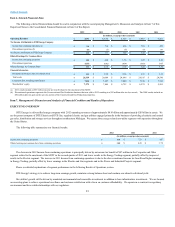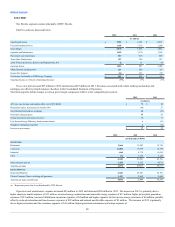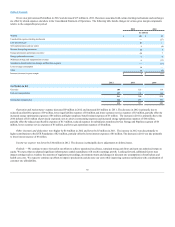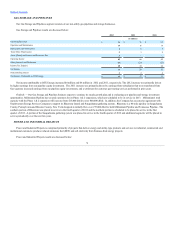DTE Energy 2012 Annual Report Download - page 28
Download and view the complete annual report
Please find page 28 of the 2012 DTE Energy annual report below. You can navigate through the pages in the report by either clicking on the pages listed below, or by using the keyword search tool below to find specific information within the annual report.
Table of Contents
We have significant investments in our non-utility businesses. We employ disciplined investment criteria when assessing meaningful, low-risk growth
opportunities that leverage our assets, skills and expertise and provide diversity in earnings and geography. Specifically, we invest in targeted energy markets
with attractive competitive dynamics where meaningful scale is in alignment with our risk profile. We expect growth opportunities in the Gas Storage and
Pipelines and Power and Industrial Projects segments.
A key priority for DTE Energy is to maintain a strong balance sheet which facilitates access to capital markets and reasonably priced short-term and
long-term financing. Near-term growth will be funded through internally generated cash flows, issuance of debt and issuance of equity through our dividend
reinvestment plan and pension and other employee benefit plans. We have an enterprise risk management program that, among other things, is designed to
monitor and manage our exposure to earnings and cash flow volatility related to commodity price changes, interest rates and counterparty credit risk.
Our utility businesses require significant base capital investments each year in order to maintain and improve the reliability of their asset bases,
including power generation plants, distribution systems, storage fields and other facilities and fleets. DTE Electric's capital investments over the 2013-2017
period are estimated at $4.7 billion for base infrastructure, $1.2 billion for mandated environmental compliance requirements and $500 million for renewable
energy and energy efficiency expenditures. DTE Gas' capital investments over the 2013-2017 period are estimated at $650 million for base infrastructure and
$400 million for gas main renewal, meter move out and pipeline integrity programs. DTE Gas proposed in its rate case filing in April 2012, starting in 2013, a
five-year annual incremental Infrastructure Recovery Mechanism (IRM) to recover costs associated with capital investment for the gas main renewal and meter
move out programs. The IRM was not part of the rate case settlement approved in December 2012 and is expected to be resolved in 2013. DTE Electric and
DTE Gas both plan to seek regulatory approval in general rate case filings to include these capital expenditures within our regulatory rate base consistent with
prior general rate case filing treatment. DTE Electric is implementing a 20-year renewable energy plan to address the provisions of Michigan Public Act 295 of
2008, with the goals of delivering cleaner renewable electric generation to its customers, further diversifying DTE Electric's and the State of Michigan's sources
of electric supply and addressing the state and national goals of increasing energy independence. DTE Electric routinely files renewable energy plans, requests
for approval of renewable contracts and for recovery of renewable capital expenditures with the MPSC as the implementation of the 20-year renewable energy
plan progresses.
We are subject to extensive environmental regulation. Additional costs may result as the effects of various substances on the environment are studied and
governmental regulations are developed and implemented. Actual costs to comply could vary substantially. We expect to continue recovering environmental
costs related to utility operations through rates charged to our customers.
DTE Electric is subject to the EPA ozone and fine particulate transport and acid rain regulations that limit power plant emissions of sulfur dioxide and
nitrogen oxides. Since 2005, the EPA and the State of Michigan have issued additional emission reduction regulations relating to ozone, fine particulate,
regional haze and mercury air pollution. These rules will lead to additional emission controls on fossil-fueled power plants to reduce nitrogen oxide, sulfur
dioxide and mercury emissions. To comply with these requirements, DTE Electric has spent approximately $1.9 billion through 2012. It is estimated that
DTE Electric will make capital expenditures of approximately $335 million in 2013 and up to approximately $1.6 billion of additional capital expenditures
through 2020 based on current regulations.
Climate regulation and/or legislation has been proposed and discussed within the U.S. Congress and the EPA. The EPA is implementing regulatory
actions under the Clean Air Act to address emissions of greenhouse gases (GHGs). EPA regulation of GHGs requires the best available control technology
(BACT) for new major sources or modifications to existing major sources that cause significant increases in GHG emissions. In June 2012, the EPA proposed
new source performance standards for carbon dioxide emissions from new fossil-fueled power plants. These new source performance standards are expected to
be finalized in 2013 as well as a proposed performance standard for carbon dioxide emissions from existing plants. Pending or future legislation or other
regulatory actions could have a material impact on our operations and financial position and the rates we charge our customers. Impacts include expenditures
for environmental equipment beyond what is currently planned, financing costs related to additional capital expenditures, the purchase of emission offsets
from market sources and the retirement of facilities where control equipment is not economical. We would seek to recover these incremental costs through
increased rates charged to our utility customers. Increased costs for energy produced from traditional sources could also increase the economic viability of
energy produced from renewable and/or nuclear sources and energy efficiency initiatives and
26
























